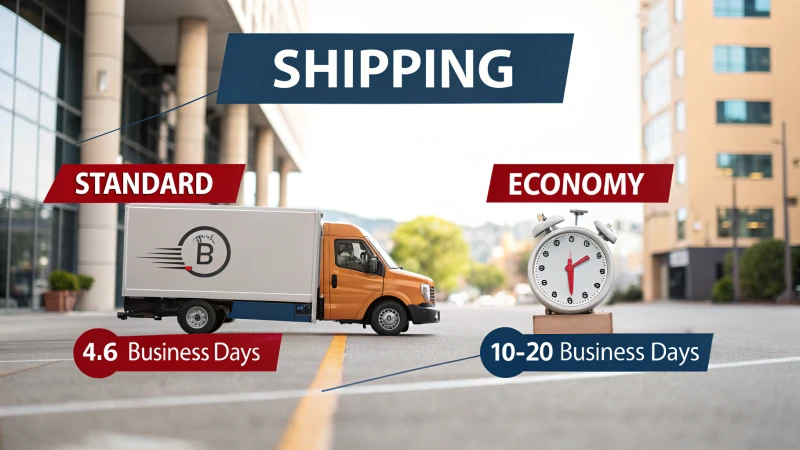Navigating the shipping maze can feel like a game of balancing speed with cost.
Standard shipping typically delivers faster, within 4-6 business days, while economy shipping takes 10-20 business days. If quick delivery is crucial, opt for standard. For cost savings, economy is your go-to.
I remember the time when I was waiting on a shipment that seemed to take forever. That experience taught me the importance of choosing the right shipping option based on my priorities. While speed is often key, sometimes a tighter budget steers us towards economy shipping. Understanding these nuances can save both time and money, especially in the world of e-commerce where delivery speed can make or break a sale.
Standard shipping delivers in 4-6 business days.True
Standard shipping typically delivers within 4-6 business days.
Economy shipping is more expensive than standard shipping.False
Economy shipping is generally cheaper but slower than standard.
What are the main differences between standard and economy shipping?
Choosing between standard and economy shipping feels like deciding whether to splurge or save on a Friday night takeaway. Each has its charm, but understanding their nuances is the key to making the right choice.
Standard shipping delivers faster, usually within 4–6 business days, whereas economy shipping takes longer, around 10–20 business days. While economy is budget-friendly, standard shipping offers quicker delivery times.
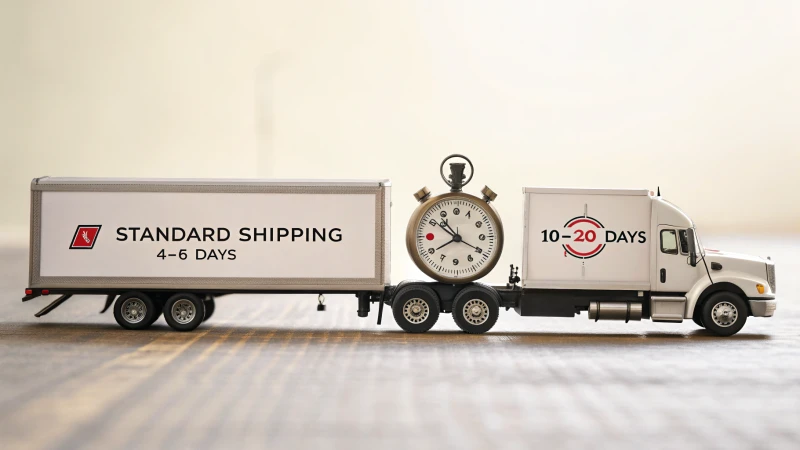
Delivery Timeframes
I remember the first time I had to choose between standard and economy shipping for my online store. It felt like deciding whether to take the scenic route or the express lane. Standard shipping promises a swift delivery, typically within 4–6 business days, perfect for those moments when time is of the essence. On the other hand, economy shipping is more like a leisurely stroll, stretching delivery times to 10–20 business days. This slower pace is due to its reliance on more economical transportation methods that prioritize savings over speed.
One of the primary distinctions between these options lies in their delivery timeframes1.
Cost Considerations
When I started my e-commerce journey, every penny counted. That's why economy shipping initially caught my eye with its lower costs. It's ideal for those of us who prioritize budget over speed. The savings come from longer transit times and possibly less direct routes.
When deciding between these options, cost considerations2 play a significant role.
Here's a comparative table:
| Shipping Type | Average Cost | Delivery Speed |
|---|---|---|
| Standard | Higher | 4-6 Days |
| Economy | Lower | 10-20 Days |
Service Quality
From my experience, the quality of service varies significantly between these options. Standard shipping often includes reliable tracking and responsive customer support, making it easier for me to keep tabs on my inventory. Economy shipping, however, tends to offer just the basics in tracking and customer service, focusing on keeping costs down.
Service quality can vary between the two options as well. Standard shipping typically includes more reliable tracking and customer support. Conversely, economy shipping3 might offer basic tracking and limited customer service.
Best Use Cases
In my business, choosing the right shipping method can make or break a season. If I'm running low on stock and need a quick restock, standard shipping is my go-to. But when I'm planning ahead and cost efficiency is more important than speed, economy shipping becomes a valuable option.
For businesses like Linda's e-commerce store, choosing the right shipping method depends on inventory needs and budget.
Understanding these differences has helped me streamline my logistics strategy effectively, ensuring I strike a balance between speed and cost savings—something every business owner dreams of achieving.
Standard shipping delivers in 4-6 business days.True
Standard shipping aims to deliver parcels within 4–6 business days.
Economy shipping offers comprehensive customer support.False
Economy shipping might offer limited customer service to keep costs down.
How does distance affect shipping times?
Ever wondered why some packages take longer to reach you than others? It all boils down to distance, a crucial factor that can make or break your delivery timeline.
Shipping times are directly influenced by distance—the further away your package needs to go, the longer it will likely take due to travel time and potential customs checks. To strike a balance between cost and speed for long-distance deliveries, standard shipping is often your best bet.
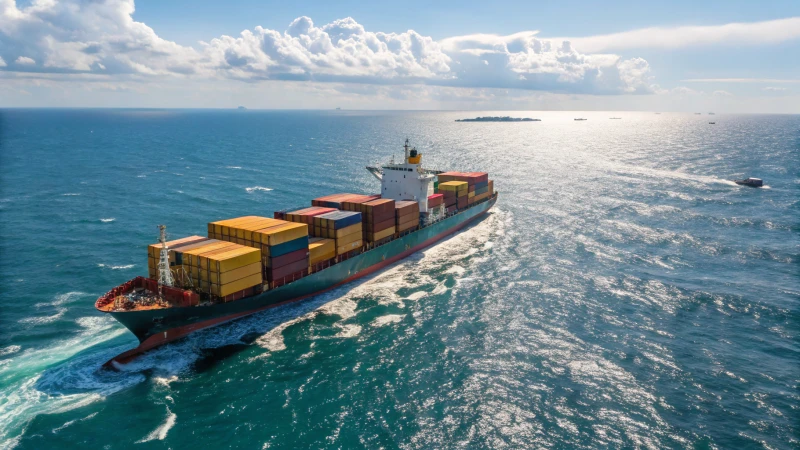
I still remember the first time I ordered something from halfway across the world. It felt like a race against time, waiting for that package to arrive. Distance is more than just a number—it’s the journey your parcel takes, filled with hurdles and checkpoints.
Impact of Distance on Shipping Options
When you're deciding on shipping methods, distance becomes the star player. I found that for shorter trips, ground shipping was my go-to. It’s cost-effective and usually quick. But when I started shipping to farther places, like across oceans, air or sea freight became necessary. Each choice comes with its own set of cost and speed considerations4.
| Shipping Method | Distance | Average Time |
|---|---|---|
| Ground | <500 miles | 1-3 days |
| Air | <3000 miles | 1-5 days |
| Sea | >3000 miles | 20-30 days |
Challenges with Long-Distance Shipping
I’ve learned that shipping over long distances isn’t just about covering miles. Customs processing and regional regulations5 can throw a wrench in your plans. Navigating these requirements is crucial to avoid delays.
The Role of Carriers
Different carriers can change how quickly your package gets from A to B. I’ve noticed that companies like FedEx or USPS offer expedited services that help reduce the impact of distance on shipping times. It's worth exploring carrier-specific strategies6 when you're dealing with long-distance deliveries.
Distance and Cost Efficiency
Longer routes usually mean higher costs due to fuel and handling fees—something I’ve had to factor into my budget. Freight consolidation has been a helpful strategy for managing these costs effectively. Looking into freight solutions7 has been beneficial for optimizing my supply chain.
In conclusion, getting to grips with how distance affects shipping times is key when choosing the right method for your needs. By understanding different carriers and considering factors like customs and cost efficiency, I’ve been able to enhance my logistics strategies.
Air shipping is fastest for distances over 3000 miles.False
Sea freight is used for distances over 3000 miles, not air shipping.
Customs processing can delay long-distance shipments.True
Customs and regional regulations often cause delays in long-distance shipping.
How does choosing standard over economy shipping affect costs?
Choosing between standard and economy shipping feels like deciding between a quick coffee fix and a leisurely brew at home.
Opting for standard shipping means paying more for speed, perfect for urgent deliveries. Economy shipping is cheaper, suitable for less time-sensitive packages but may lead to customer dissatisfaction due to longer waits.
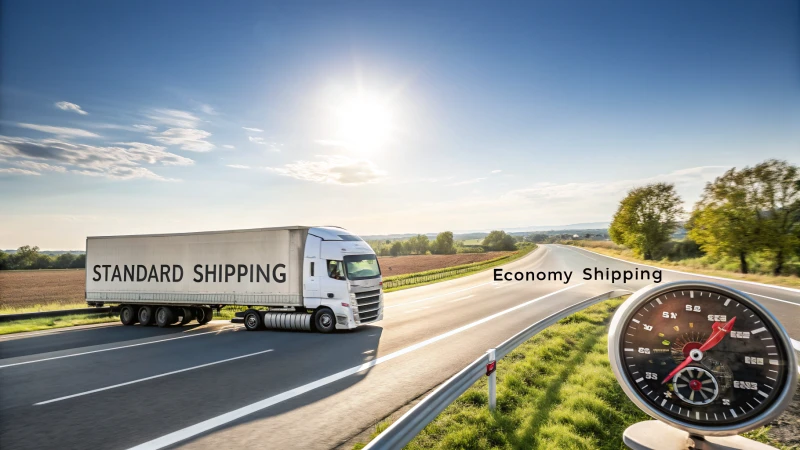
Understanding the Cost Dynamics
I remember the first time I had to choose between standard8 and economy shipping for my business. It was like standing at a crossroads, each path offering its own perks and pitfalls. Standard shipping was tempting because it promised swift delivery, usually between 4–6 business days. It's like having a reliable friend who always shows up on time. But, as with most good things, this reliability came with a price tag.
Economy shipping, however, played the role of the budget-friendly option, stretching the delivery time to about 10–20 business days. It reminded me of those long summer road trips where the journey was as important as the destination. For someone focused on pinching pennies, it seemed like a sensible choice—unless, of course, the wait became unbearable.
Analyzing the Cost-Benefit Equation
Consider the following table showcasing potential cost differences:
| Shipping Method | Average Cost | Delivery Time |
|---|---|---|
| Standard | £10-£20 | 4–6 days |
| Economy | £5-£10 | 10–20 days |
This comparison often left me pondering whether doubling the cost for quicker delivery was truly worth it. I found myself considering not just my needs but also those of my customers. What would make them happier? What would keep them coming back?
Impact on Customer Satisfaction
In my line of work, ensuring that customers are satisfied is just as crucial as managing costs. There were times when I opted for standard shipping to keep them smiling and their patience intact. Yet, there were also instances when economy shipping sufficed, particularly when I could manage their expectations upfront.
Balancing these decisions often felt like a tightrope walk. For instance, when I needed to restock popular items quickly, the extra expense for standard shipping9 seemed justified. On quieter days, when inventory wasn't flying off the shelves, economy shipping was my go-to.
In navigating these choices, I've learned that flexibility is key. Crafting a shipping policy that adapts to various scenarios and customer preferences isn't just smart—it's essential. After all, keeping both the bottom line and customer satisfaction in check can feel like juggling flaming torches, but with the right strategy, it's entirely doable.
Standard shipping is always more cost-effective than economy.False
Standard shipping is more expensive due to faster delivery times.
Economy shipping can take up to 20 business days for delivery.True
Economy shipping prioritizes cost, resulting in longer delivery times.
Are there any hidden costs associated with economy shipping?
Ever ordered a budget-friendly shipping option only to face unexpected charges? You're not alone. Economy shipping often hides sneaky fees that can catch you off guard.
Economy shipping can come with hidden costs such as handling fees, fuel surcharges, and customs duties. Recognizing these extra expenses ensures you plan your budget wisely when opting for economy shipping services.

Understanding Hidden Fees in Economy Shipping
When I first started my e-commerce journey, I quickly learned that economy shipping was like a tempting mirage—affordable at first glance but potentially costly if you're not careful. These hidden fees can creep up, impacting the bottom line without a whisper.
Common Hidden Costs:
| Fee Type | Description |
|---|---|
| Handling Fees | Additional charges for processing and handling your shipment. |
| Fuel Surcharges | Variable charges based on fluctuating fuel prices. |
| Customs Duties | Taxes levied on goods when crossing international borders. |
How Handling Fees Affect Your Shipment
Handling fees are like those sneaky extra charges that pop up at the last minute. I remember one particular shipment where the handling fees almost doubled what I initially thought was a great deal. These fees account for the physical labor and logistics involved in moving your package from point A to point B. Understanding these can help you prevent any budget blowouts.
The Impact of Fuel Surcharges
Fuel surcharges can feel like a wild card—one moment they’re manageable, and the next, they’re spiking due to global fuel price changes. It’s like when you're driving and suddenly notice the petrol prices have skyrocketed overnight. Keeping an eye on current rates is crucial, much like checking the weather forecast before planning an outdoor event. Learn more about fuel surcharge calculations10.
Navigating Customs Duties
I’ve had shipments that seemed straightforward until they hit the customs stage. That’s when I realized how customs duties could sneak in as an unplanned expense, especially for international shipments. These are taxes based on your goods' value and the destination country's rules. Getting familiar with customs duty regulations11 can save you from unexpected costs.
Tips for Budgeting Economy Shipping
- Get Detailed Quotes: I’ve learned to always ask for comprehensive quotes that list potential hidden fees to avoid surprises.
- Understand Local Regulations: Knowing specific destination requirements can make or break a budget.
- Monitor Fuel Prices: Just as I check the stock market for my investments, keeping track of fuel price trends helps anticipate possible surcharges.
By taking these steps, you can better navigate the complexities of economy shipping and avoid unexpected costs. Whether you're shipping for business or personal reasons12, being informed will help you make the most cost-effective decision.
Economy shipping always includes handling fees.False
Handling fees are common but not guaranteed in every economy shipping.
Fuel surcharges can vary with fuel price changes.True
Fuel surcharges fluctuate based on current fuel price trends.
How do shipping times affect customer satisfaction in e-commerce?
Ever ordered something online and eagerly waited for it to arrive, only to be left hanging by slow shipping? We've all been there, and it's no fun.
Shipping times are crucial in e-commerce because they shape delivery expectations and influence trust and loyalty. Quick deliveries boost satisfaction, while delays can lead to bad reviews and lost customers.
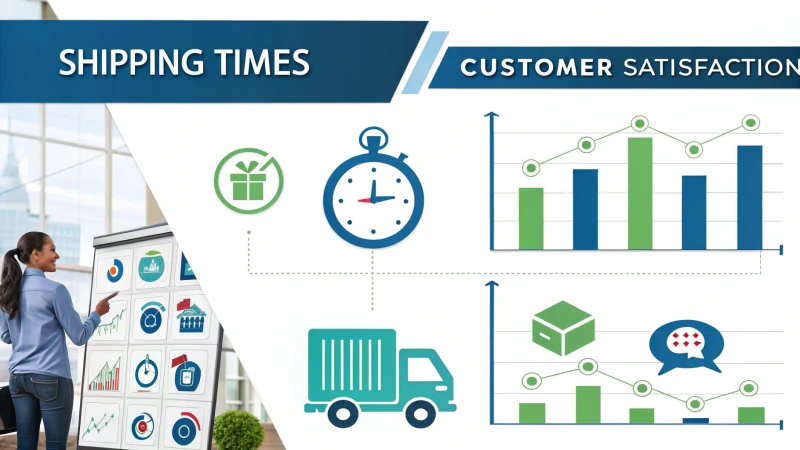
The Importance of Meeting Delivery Expectations
Remember the thrill of buying something online and the anticipation as you track its journey? Customers have high hopes that their orders will arrive on time or even early. That's why hitting those estimated delivery dates is so vital. It's not just about getting a package; it's about the promise that comes with it. When I manage to meet or even beat these timelines, it feels like a win, both for me and my customers. It’s like saying, "Hey, you can count on me!"
| Delivery Type | Expected Timeframe | Impact on Satisfaction |
|---|---|---|
| Standard | 4–6 business days | High if on time |
| Economy | 10–20 business days | Moderate if timely |
Missing these expectations? Well, it doesn't just disappoint—it can lead to those dreaded negative reviews13 and poor ratings.
Trust and Customer Loyalty
Think about how you feel when a delivery arrives exactly when expected, or even earlier. It’s like a surprise gift! This trust is the cornerstone of turning first-time buyers into loyal fans. A study I came across mentioned that 87% of customers are more likely to return after a positive delivery experience. It's amazing how much trust hinges on something as simple as getting a package on time.
Negative Impacts of Delays
On the flip side, shipping delays can be quite damaging. Imagine you've promised a friend you'll bring a dish to a party, but you arrive empty-handed because the ingredients didn’t arrive on time. It’s awkward and disappointing. Delays not only upset customers but increase returns and refunds. Worse, they might drive your customers straight into the arms of competitors.
- Loss of Trust: Consistent delays can really shake confidence.
- Reduced Loyalty: Customers may start shopping elsewhere.
Strategies for Enhancing Shipping Times
So how do we avoid these pitfalls? Here are a few strategies I’ve found helpful:
- Streamline supply chain processes14 to be as efficient as possible.
- Offer a variety of shipping options to cater to different needs.
- Be upfront with customers about any potential delays.
These tactics can significantly improve delivery times, enhancing overall customer satisfaction and loyalty. After all, ensuring that special package gets to its destination on time isn’t just about logistics—it's about keeping promises.
Meeting delivery expectations increases customer trust.True
Timely deliveries foster trust and satisfaction, encouraging repeat purchases.
Shipping delays have no effect on customer loyalty.False
Delays erode trust, leading customers to seek more reliable competitors.
What factors should you consider when choosing a shipping method?
Choosing the right shipping method can feel like solving a tricky puzzle, especially when juggling costs, speed, and reliability. Whether you're a seasoned business owner or just diving into logistics, finding the best fit is key to keeping your operations smooth.
Choosing a shipping method means weighing costs, delivery speed, reliability, and your goods' nature. Consider factors like destination, shipping volume, and special handling needs to streamline your logistics strategy effectively.
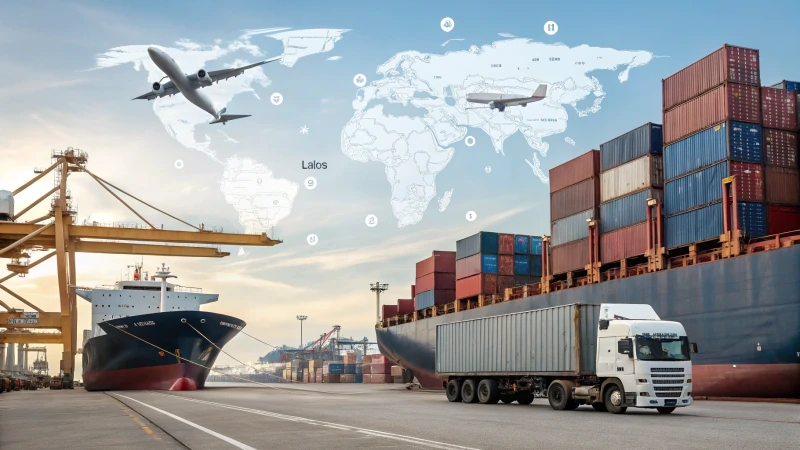
Cost vs. Speed
Picture this: I’m eagerly waiting for a batch of my best-selling accessories to arrive. Do I choose the quicker standard shipping or save some cash with economy? Balancing these choices is all about figuring out what matters more at that moment—speed or budget.
| Shipping Method | Average Delivery Time | Cost Level |
|---|---|---|
| Standard | 4-6 Business Days | Moderate |
| Economy | 10-20 Business Days | Low |
So, do I prioritize my budget or my timeline?
Reliability and Security
Nothing beats the peace of mind that comes with knowing my packages will arrive safely. I've learned to trust carriers with a solid track record for on-time deliveries and secure handling. Whether it’s fragile jewelry or expensive bags, ensuring reliable delivery builds trust with my customers. Sometimes this means opting for additional security measures15, like insurance or special packaging.
Nature of Goods
Shipping delicate fashion accessories isn’t just about getting from point A to B; it's about ensuring they arrive in perfect condition. Fragile items demand extra care, while perishables need temperature-controlled environments. Understanding the specific needs of my products16 helps me choose the best shipping method, ensuring they reach customers in tip-top shape.
Destination and Volume
Shipping to different countries adds layers of complexity—think customs procedures and destination regulations. The shipment size can also determine whether I need container or pallet shipping. Navigating international logistics17 effectively ensures smoother operations and happier customers.
Special Handling Requirements
Dealing with unique items often means adhering to strict guidelines. Hazardous materials, for instance, have their own set of rules. By understanding any special handling needs my products may have, I ensure my chosen shipping method accommodates these requirements seamlessly.
Evaluating these factors thoughtfully allows me to align my shipping method with my operational goals, boosting both efficiency and customer satisfaction. Each decision I make brings me closer to offering a seamless shopping experience.
Standard shipping is faster than economy shipping.True
Standard shipping typically delivers in 4-6 days, while economy takes 10-20 days.
Perishable goods don't need special shipping conditions.False
Perishables require temperature-controlled environments to maintain freshness during transit.
Conclusion
Standard shipping is faster (4-6 days) than economy shipping (10-20 days). Choose based on urgency or budget to optimize delivery for e-commerce needs.
-
Discover more about how delivery time impacts your choice of shipping method. ↩
-
Explore a detailed comparison of costs between shipping methods. ↩
-
Learn how service quality differs between standard and economy options. ↩
-
Explore how different shipping methods are affected by distance to choose the most efficient option. ↩
-
Learn about how regional customs regulations can affect your shipping timelines over long distances. ↩
-
Discover how major carriers manage long-distance deliveries to ensure timely arrival of goods. ↩
-
Understand how consolidating shipments can reduce costs and improve efficiency in long-distance logistics. ↩
-
This link will provide in-depth insights into how standard and economy shipping costs differ, helping you make a more informed decision. ↩
-
Explore this resource to understand when it's worth investing in standard shipping over economy based on your specific needs. ↩
-
Discover how fuel surcharges are determined and their impact on shipping costs. ↩
-
Learn about customs duty regulations to prevent unexpected international shipping costs. ↩
-
Find strategies to budget efficiently for economy shipping, balancing cost and service. ↩
-
Discusses how negative reviews from delayed shipments can harm an e-commerce business's reputation. ↩
-
Offers insights into improving supply chain processes to enhance delivery speed and reliability. ↩
-
Discover how to enhance the security of your shipments by exploring best practices that protect goods during transit. ↩
-
Understand how different product types influence shipping choices to ensure safe and efficient delivery. ↩
-
Learn about international logistics complexities, helping you navigate global shipping more effectively. ↩

